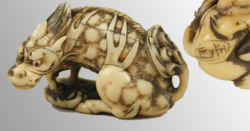Collecting Rare Japanese Netsuke offers the Oriental enthusiast an opportunity to dive headlong into Japanese history & culture. Netsuke feature scenes from everyday Japanese life and Japanese religions from Buddhism to Shintoism. Netsuke come in various forms and styles and the collector should understand the difference between Sashi, Kagamibuta and Ichiraku Netsuke.
Japanese Netsuke are a uniquely Japanese art form
These superb objects of wood, ivory and ceramics, as well as dozens of other materials, tell the story of Japan from its earliest times.
They include the peasant, the fisherman, the beggar rubbing shoulders with the scholar, the samurai, the warrior, as well as a wonderful assortment of Japanese Netsuke animals, fish, insects and gods.
Japanese Netsuke depict subjects as diverse as daily living, eggplants, tea bowls, and flowers. Rare Netsuke forms encompass the mythology as well as the religions of Japan from Buddhism to Shintoism.
The photo on the right features a Rare Japanese Ivory Netsuke as a Kirin and is signed Masanao
Japanese Netsuke were produced as early as the 17thC in a wide variety of materials
They eventually became redundant when the Japanese adopted Western dress in the 1870s. Most netsuke take the form of figures, animals or plants but there are some variations: for example Manju (rice cake) resembles a bun that is either solid or pierced.
- Ichiraku Netsuke is made from woven or braided metal, rattan palm or bamboo, forming a basketwork box or gourd.
- Kagamibuta Netsuke is a shallow bowl with a decorated metal lid.
- Sashi Netsuke are rod-shaped, up to 5 in (12.5 cm) long, typically depicting an insect or animal perched on a twig or branch.
Browse the above listing to find rare and collectable Japanese Netsuke to add to your Oriental porcelain collection.





